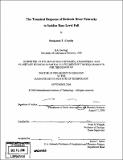The transient response of bedrock river networks to sudden base level fall
Author(s)
Crosby, Benjamin T. (Benjamin Thomas)
DownloadFull printable version (30.14Mb)
Other Contributors
Massachusetts Institute of Technology. Dept. of Earth, Atmospheric, and Planetary Sciences.
Advisor
Kelin X. Whipple.
Terms of use
Metadata
Show full item recordAbstract
Following a change in the factors that determine landscape form, a transient signal of adjustment propagates through the river network, progressively adjusting channels and hillslopes to the new conditions. When conditions favor incision, the rate and mechanism by which this signal propagates throughout the network determines basin response time. This ultimately influences the growth and stability of mountain ranges and the tempo of sediment delivery to depositional basins. As this incision signal propagates through the river network, its upstream extent is often recognized as a discrete, steep convexity in the channel profile, defined here as a knickpoint. In this thesis, theoretical, numerical, and field-based research techniques are utilized to study the initiation and distribution of knickpoints within fluvial networks. Field observations are derived from the Waipaoa River on the North Island of New Zealand. In the Waipaoa, 236 knickpoints distributed throughout the network define the upstream extent of a large magnitude incision signal initiated -18,000 years ago. These features, frequently located at the confluence between small drainage area tributaries and trunk-streams, are characterized as near-vertical single or multi-step waterfalls. (cont.) Though flights of trunk-stream strath terraces document a prolonged incision history, the single step knickpoints upstream of tributary junctions suggest that trunk-stream incision can outpace tributary response, producing fluvial hanging valleys. Variations in knickpoint form observed in non-hanging tributaries demonstrate that many factors, both internal and external to the tributary, ultimately determine knickpoint form. We use a two dimensional numerical landscape evolution model (CHILD) to test a suite of bedrock channel incision rules to determine whether instantaneous or prolonged base level fall can trigger erosion thresholds. These experiments reveal that for bedrock channel incision rules where the relationship between slope and erosion rate is not positive and monotonic, incision rate can decrease with increasing slope until the incision rate is less than the background uplift rate. This provides a mechanism for hanging valley formation when over-steepened tributaries cannot incise at rates equal to the incision in the mainstem. This suggests that if trunk-stream incision outpaces tributary response, hanging valleys form, thus limiting the upstream propagation of incision signals and ultimately increasing basin response time.
Description
Thesis (Ph. D.)--Massachusetts Institute of Technology, Dept. of Earth, Atmospheric, and Planetary Sciences, 2006. Includes bibliographical references.
Date issued
2006Department
Massachusetts Institute of Technology. Department of Earth, Atmospheric, and Planetary SciencesPublisher
Massachusetts Institute of Technology
Keywords
Earth, Atmospheric, and Planetary Sciences.